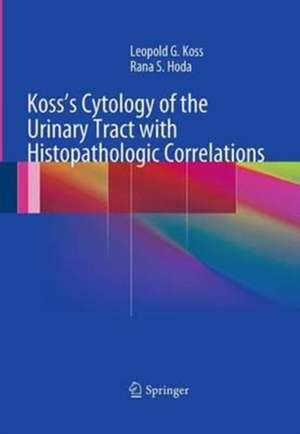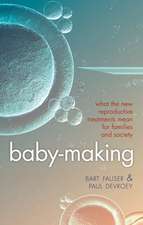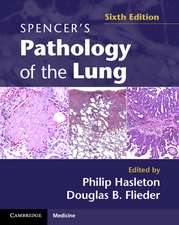Koss's Cytology of the Urinary Tract with Histopathologic Correlations
Autor Leopold G. Koss, MD, FCRP, Rana S. Hoda, MD, FIACen Limba Engleză Paperback – 22 aug 2016
| Toate formatele și edițiile | Preț | Express |
|---|---|---|
| Paperback (1) | 898.77 lei 6-8 săpt. | |
| Springer – 22 aug 2016 | 898.77 lei 6-8 săpt. | |
| Hardback (1) | 908.27 lei 3-5 săpt. | |
| Springer – 6 feb 2012 | 908.27 lei 3-5 săpt. |
Preț: 898.77 lei
Preț vechi: 946.07 lei
-5% Nou
Puncte Express: 1348
Preț estimativ în valută:
171.100€ • 186.77$ • 144.48£
171.100€ • 186.77$ • 144.48£
Carte tipărită la comandă
Livrare economică 22 aprilie-06 mai
Preluare comenzi: 021 569.72.76
Specificații
ISBN-13: 9781493952755
ISBN-10: 1493952757
Pagini: 125
Ilustrații: XVI, 125 p.
Dimensiuni: 178 x 254 mm
Greutate: 0.26 kg
Ediția:Softcover reprint of the original 1st ed. 2012
Editura: Springer
Colecția Springer
Locul publicării:New York, NY, United States
ISBN-10: 1493952757
Pagini: 125
Ilustrații: XVI, 125 p.
Dimensiuni: 178 x 254 mm
Greutate: 0.26 kg
Ediția:Softcover reprint of the original 1st ed. 2012
Editura: Springer
Colecția Springer
Locul publicării:New York, NY, United States
Cuprins
Chapter 1- Introduction
Chapter 2- Indication, Collection and Laboratory Processing of Cytologic Samples
Principal Indication
Collection Techniques
Laboratory Processing of Samples
Suggested Reading
Chapter 3- The Cellular and Acellular Components of the Urinary Sediment
Normal Urothelium (Transitional Epithelium) and Its Cells
Other Benign Cells
Noncellular Components of the Urinary Sediment
Suggested Reading
Chapter 4- The Cytologic Makeup of the Urinary Sediment According to the Collection Technique
Voided urine
Cytologic Makeup of Bladder Washings
Cytologic Makeup of Normal Specimens Obtained by Retrograde Catheterization
Cytologic Makeup of Smears Obtained by Brushing
Cytologic Makeup of Ileal Bladder Urine
Chapter 5- Cytologic Manifestations of Benign Disorders Affecting Cells of the
Lower Urinary Tract
Inflammatory disorders
Cellular inclusions not due to viral agents
Trematodes and other parasites
Lithiasis
Leukoplakia
Effect of Drugs
Effects of radiotherapy
Monitoring of renal transplant patients
Urinary Cytology in Renal Transplant Patients
Rare benign conditions
Suggested Reading
Chapter 6- Tumors of the Bladder
Non-Neoplastic Changes
Hyperplasia
Inverted papilloma
Urothelial (Transitional) Cell Tumors
Epidemiology
Classification and natural history
Types of Urothelial Tumors
A. Papillary Urothelial Neoplasms
I. Tumors with No/Minimal Nuclear Atypia
Papilloma, PUNLMP, low grade Papillary Urothelial Carcinoma
II. High-Grade Papillary Urothelial Carcinoma
B. Nonpapillary Urothelial Tumors
I. Invasive Urothelial Carcinomas
II. Flat Carcinoma In Situ (IUN III): Clinical Presentation, Histology
Histologic Variants of Urothelial Carcinoma
Metastatic Tumors
Cytologic Monitoring of Patients Treated for Tumors of Lower Urinary Tract
Reporting of cytologic findings
Suggested Reading
Chapter 7- Immunohistochemistry, Immunocytochemistry and Other Methods of Detection of Bladder Neoplasms
Introduction
US FDA-approved Markers
Potential Markers in Earlier Phases of Clinical Development
Markers Detected by Immunocytochemistry
Comparison between Urine Cytology and FDA-approved Markers
Conclusion
References
Chapter 4- The Cytologic Makeup of the Urinary Sediment According to the Collection Technique
Voided urine
Cytologic Makeup of Bladder Washings
Cytologic Makeup of Normal Specimens Obtained by Retrograde Catheterization
Cytologic Makeup of Smears Obtained by Brushing
Cytologic Makeup of Ileal Bladder Urine
Chapter 5- Cytologic Manifestations of Benign Disorders Affecting Cells of the
Lower Urinary Tract
Inflammatory disorders
Cellular inclusions not due to viral agents
Trematodes and other parasites
Lithiasis
Leukoplakia
Effect of Drugs
Effects of radiotherapy
Monitoring of renal transplant patients
Urinary Cytology in Renal Transplant Patients
Rare benign conditions
Suggested Reading
Chapter 6- Tumors of the Bladder
Non-Neoplastic Changes
Hyperplasia
Inverted papilloma
Urothelial (Transitional) Cell Tumors
Epidemiology
Classification and natural history
Types of Urothelial Tumors
A. Papillary Urothelial Neoplasms
I. Tumors with No/Minimal Nuclear Atypia
Papilloma, PUNLMP, low grade Papillary Urothelial Carcinoma
II. High-Grade Papillary Urothelial Carcinoma
B. Nonpapillary Urothelial Tumors
I. Invasive Urothelial Carcinomas
II. Flat Carcinoma In Situ (IUN III): Clinical Presentation, Histology
Histologic Variants of Urothelial Carcinoma
Metastatic Tumors
Cytologic Monitoring of Patients Treated for Tumors of Lower Urinary Tract
Reporting of cytologic findings
Suggested Reading
Chapter 7- Immunohistochemistry, Immunocytochemistry and Other Methods of Detection of Bladder Neoplasms
Introduction
US FDA-approved Markers
Potential Markers in Earlier Phases of Clinical Development
Markers Detected by Immunocytochemistry
Comparison between Urine Cytology and FDA-approved Markers
Conclusion
References
Cellular inclusions not due to viral agents
Trematodes and other parasites
Lithiasis
Leukoplakia
Effect of Drugs
Effects of radiotherapy
Monitoring of renal transplant patients
Urinary Cytology in Renal Transplant Patients
Rare benign conditions
Suggested Reading
Chapter 6- Tumors of the Bladder
Non-Neoplastic Changes
Hyperplasia
Inverted papilloma
Urothelial (Transitional) Cell Tumors
Epidemiology
Classification and natural history
Types of Urothelial Tumors
A. Papillary Urothelial Neoplasms
I. Tumors with No/Minimal Nuclear Atypia
Papilloma, PUNLMP, low grade Papillary Urothelial Carcinoma
II. High-Grade Papillary Urothelial Carcinoma
B. Nonpapillary Urothelial Tumors
I. Invasive Urothelial Carcinomas
II. Flat Carcinoma In Situ (IUN III): Clinical Presentation, Histology
Histologic Variants of Urothelial Carcinoma
Metastatic Tumors
Cytologic Monitoring of Patients Treated for Tumors of Lower Urinary Tract
Reporting of cytologic findings
Suggested Reading
Chapter 7- Immunohistochemistry, Immunocytochemistry and Other Methods of Detection of Bladder Neoplasms
Introduction
US FDA-approved Markers
Potential Markers in Earlier Phases of Clinical Development
Markers Detected by Immunocytochemistry
Comparison between Urine Cytology and FDA-approved Markers
Conclusion
References
Chapter 4- The Cytologic Makeup of the Urinary Sediment According to the Collection Technique
Voided urine
Cytologic Makeup of Bladder Washings
Cytologic Makeup of Normal Specimens Obtained by Retrograde Catheterization
Cytologic Makeup of Smears Obtained by Brushing
Cytologic Makeup of Ileal Bladder Urine
Chapter 5- Cytologic Manifestations of Benign Disorders Affecting Cells of the
Lower Urinary Tract
Inflammatory disorders
Cellular inclusions not due to viral agents
Trematodes and other parasites
Lithiasis
Leukoplakia
Effect of Drugs
Effects of radiotherapy
Monitoring of renal transplant patients
Urinary Cytology in Renal Transplant Patients
Rare benign conditions
Suggested Reading
Chapter 6- Tumors of the Bladder
Non-Neoplastic Changes
Hyperplasia
Inverted papilloma
Urothelial (Transitional) Cell Tumors
Epidemiology
Classification and natural history
Types of Urothelial Tumors
A. Papillary Urothelial Neoplasms
I. Tumors with No/Minimal Nuclear Atypia
Papilloma, PUNLMP, low grade Papillary Urothelial Carcinoma
II. High-Grade Papillary Urothelial Carcinoma
B. Nonpapillary Urothelial Tumors
I. Invasive Urothelial Carcinomas
II. Flat Carcinoma In Situ (IUN III): Clinical Presentation, Histology
Histologic Variants of Urothelial Carcinoma
Metastatic Tumors
Cytologic Monitoring of Patients Treated for Tumors of Lower Urinary Tract
Reporting of cytologic findings
Suggested Reading
Chapter 7- Immunohistochemistry, Immunocytochemistry and Other Methods of Detection of Bladder Neoplasms
Introduction
US FDA-approved Markers
Potential Markers in Earlier Phases of Clinical Development
Markers Detected by Immunocytochemistry
Comparison between Urine Cytology and FDA-approved Markers
Conclusion
References
Cellular inclusions not due to viral agents
Trematodes and other parasites
Lithiasis
Leukoplakia
Effect of Drugs
Effects of radiotherapy
Monitoring of renal transplant patients
Urinary Cytology in Renal Transplant Patients
Rare benign conditions
Suggested Reading
Chapter 6- Tumors of the Bladder
Non-Neoplastic Changes
Hyperplasia
Inverted papilloma
Urothelial (Transitional) Cell Tumors
Epidemiology
Classification and natural history
Types of Urothelial Tumors
A. Papillary Urothelial Neoplasms
I. Tumors with No/Minimal Nuclear Atypia
Papilloma, PUNLMP, low grade Papillary Urothelial Carcinoma
II. High-Grade Papillary Urothelial Carcinoma
B. Nonpapillary Urothelial Tumors
I. Invasive Urothelial Carcinomas
II. Flat Carcinoma In Situ (IUN III): Clinical Presentation, Histology
Histologic Variants of Urothelial Carcinoma
Metastatic Tumors
Cytologic Monitoring of Patients Treated for Tumors of Lower Urinary Tract
Reporting of cytologic findings
Suggested Reading
Chapter 7- Immunohistochemistry, Immunocytochemistry and Other Methods of Detection of Bladder Neoplasms
Introduction
US FDA-approved Markers
Potential Markers in Earlier Phases of Clinical Development
Markers Detected by Immunocytochemistry
Comparison between Urine Cytology and FDA-approved Markers
Conclusion
References
Cellular inclusions not due to viral agents
Trematodes and other parasites
Lithiasis
Leukoplakia
Effect of Drugs
Effects of radiotherapy
Monitoring of renal transplant patients
Urinary Cytology in Renal Transplant Patients
Rare benign conditions
Suggested Reading
Chapter 6- Tumors of the Bladder
Non-Neoplastic Changes
Hyperplasia
Inverted papilloma
Urothelial (Transitional) Cell Tumors
Epidemiology
Classification and natural history
Types of Urothelial Tumors
A. Papillary Urothelial Neoplasms
I. Tumors with No/Minimal Nuclear Atypia
Papilloma, PUNLMP, low grade Papillary Urothelial Carcinoma
II. High-Grade Papillary Urothelial Carcinoma
B. Nonpapillary Urothelial Tumors
I. Invasive Urothelial Carcinomas
II. Flat Carcinoma In Situ (IUN III): Clinical Presentation, Histology
Histologic Variants of Urothelial Carcinoma
Metastatic Tumors
Cytologic Monitoring of Patients Treated for Tumors of Lower Urinary Tract
Reporting of cytologic findings
Suggested Reading
Chapter 7- Immunohistochemistry, Immunocytochemistry and Other Methods of Detection of Bladder Neoplasms
Introduction
US FDA-approved Markers
Potential Markers in Earlier Phases of Clinical Development
Markers Detected by Immunocytochemistry
Comparison between Urine Cytology and FDA-approved Markers
Conclusion
References
Chapter 2- Indication, Collection and Laboratory Processing of Cytologic Samples
Principal Indication
Collection Techniques
Laboratory Processing of Samples
Suggested Reading
Chapter 3- The Cellular and Acellular Components of the Urinary Sediment
Normal Urothelium (Transitional Epithelium) and Its Cells
Other Benign Cells
Noncellular Components of the Urinary Sediment
Suggested Reading
Chapter 4- The Cytologic Makeup of the Urinary Sediment According to the Collection Technique
Voided urine
Cytologic Makeup of Bladder Washings
Cytologic Makeup of Normal Specimens Obtained by Retrograde Catheterization
Cytologic Makeup of Smears Obtained by Brushing
Cytologic Makeup of Ileal Bladder Urine
Chapter 5- Cytologic Manifestations of Benign Disorders Affecting Cells of the
Lower Urinary Tract
Inflammatory disorders
Cellular inclusions not due to viral agents
Trematodes and other parasites
Lithiasis
Leukoplakia
Effect of Drugs
Effects of radiotherapy
Monitoring of renal transplant patients
Urinary Cytology in Renal Transplant Patients
Rare benign conditions
Suggested Reading
Chapter 6- Tumors of the Bladder
Non-Neoplastic Changes
Hyperplasia
Inverted papilloma
Urothelial (Transitional) Cell Tumors
Epidemiology
Classification and natural history
Types of Urothelial Tumors
A. Papillary Urothelial Neoplasms
I. Tumors with No/Minimal Nuclear Atypia
Papilloma, PUNLMP, low grade Papillary Urothelial Carcinoma
II. High-Grade Papillary Urothelial Carcinoma
B. Nonpapillary Urothelial Tumors
I. Invasive Urothelial Carcinomas
II. Flat Carcinoma In Situ (IUN III): Clinical Presentation, Histology
Histologic Variants of Urothelial Carcinoma
Metastatic Tumors
Cytologic Monitoring of Patients Treated for Tumors of Lower Urinary Tract
Reporting of cytologic findings
Suggested Reading
Chapter 7- Immunohistochemistry, Immunocytochemistry and Other Methods of Detection of Bladder Neoplasms
Introduction
US FDA-approved Markers
Potential Markers in Earlier Phases of Clinical Development
Markers Detected by Immunocytochemistry
Comparison between Urine Cytology and FDA-approved Markers
Conclusion
References
Chapter 4- The Cytologic Makeup of the Urinary Sediment According to the Collection Technique
Voided urine
Cytologic Makeup of Bladder Washings
Cytologic Makeup of Normal Specimens Obtained by Retrograde Catheterization
Cytologic Makeup of Smears Obtained by Brushing
Cytologic Makeup of Ileal Bladder Urine
Chapter 5- Cytologic Manifestations of Benign Disorders Affecting Cells of the
Lower Urinary Tract
Inflammatory disorders
Cellular inclusions not due to viral agents
Trematodes and other parasites
Lithiasis
Leukoplakia
Effect of Drugs
Effects of radiotherapy
Monitoring of renal transplant patients
Urinary Cytology in Renal Transplant Patients
Rare benign conditions
Suggested Reading
Chapter 6- Tumors of the Bladder
Non-Neoplastic Changes
Hyperplasia
Inverted papilloma
Urothelial (Transitional) Cell Tumors
Epidemiology
Classification and natural history
Types of Urothelial Tumors
A. Papillary Urothelial Neoplasms
I. Tumors with No/Minimal Nuclear Atypia
Papilloma, PUNLMP, low grade Papillary Urothelial Carcinoma
II. High-Grade Papillary Urothelial Carcinoma
B. Nonpapillary Urothelial Tumors
I. Invasive Urothelial Carcinomas
II. Flat Carcinoma In Situ (IUN III): Clinical Presentation, Histology
Histologic Variants of Urothelial Carcinoma
Metastatic Tumors
Cytologic Monitoring of Patients Treated for Tumors of Lower Urinary Tract
Reporting of cytologic findings
Suggested Reading
Chapter 7- Immunohistochemistry, Immunocytochemistry and Other Methods of Detection of Bladder Neoplasms
Introduction
US FDA-approved Markers
Potential Markers in Earlier Phases of Clinical Development
Markers Detected by Immunocytochemistry
Comparison between Urine Cytology and FDA-approved Markers
Conclusion
References
Cellular inclusions not due to viral agents
Trematodes and other parasites
Lithiasis
Leukoplakia
Effect of Drugs
Effects of radiotherapy
Monitoring of renal transplant patients
Urinary Cytology in Renal Transplant Patients
Rare benign conditions
Suggested Reading
Chapter 6- Tumors of the Bladder
Non-Neoplastic Changes
Hyperplasia
Inverted papilloma
Urothelial (Transitional) Cell Tumors
Epidemiology
Classification and natural history
Types of Urothelial Tumors
A. Papillary Urothelial Neoplasms
I. Tumors with No/Minimal Nuclear Atypia
Papilloma, PUNLMP, low grade Papillary Urothelial Carcinoma
II. High-Grade Papillary Urothelial Carcinoma
B. Nonpapillary Urothelial Tumors
I. Invasive Urothelial Carcinomas
II. Flat Carcinoma In Situ (IUN III): Clinical Presentation, Histology
Histologic Variants of Urothelial Carcinoma
Metastatic Tumors
Cytologic Monitoring of Patients Treated for Tumors of Lower Urinary Tract
Reporting of cytologic findings
Suggested Reading
Chapter 7- Immunohistochemistry, Immunocytochemistry and Other Methods of Detection of Bladder Neoplasms
Introduction
US FDA-approved Markers
Potential Markers in Earlier Phases of Clinical Development
Markers Detected by Immunocytochemistry
Comparison between Urine Cytology and FDA-approved Markers
Conclusion
References
Chapter 4- The Cytologic Makeup of the Urinary Sediment According to the Collection Technique
Voided urine
Cytologic Makeup of Bladder Washings
Cytologic Makeup of Normal Specimens Obtained by Retrograde Catheterization
Cytologic Makeup of Smears Obtained by Brushing
Cytologic Makeup of Ileal Bladder Urine
Chapter 5- Cytologic Manifestations of Benign Disorders Affecting Cells of the
Lower Urinary Tract
Inflammatory disorders
Cellular inclusions not due to viral agents
Trematodes and other parasites
Lithiasis
Leukoplakia
Effect of Drugs
Effects of radiotherapy
Monitoring of renal transplant patients
Urinary Cytology in Renal Transplant Patients
Rare benign conditions
Suggested Reading
Chapter 6- Tumors of the Bladder
Non-Neoplastic Changes
Hyperplasia
Inverted papilloma
Urothelial (Transitional) Cell Tumors
Epidemiology
Classification and natural history
Types of Urothelial Tumors
A. Papillary Urothelial Neoplasms
I. Tumors with No/Minimal Nuclear Atypia
Papilloma, PUNLMP, low grade Papillary Urothelial Carcinoma
II. High-Grade Papillary Urothelial Carcinoma
B. Nonpapillary Urothelial Tumors
I. Invasive Urothelial Carcinomas
II. Flat Carcinoma In Situ (IUN III): Clinical Presentation, Histology
Histologic Variants of Urothelial Carcinoma
Metastatic Tumors
Cytologic Monitoring of Patients Treated for Tumors of Lower Urinary Tract
Reporting of cytologic findings
Suggested Reading
Chapter 7- Immunohistochemistry, Immunocytochemistry and Other Methods of Detection of Bladder Neoplasms
Introduction
US FDA-approved Markers
Potential Markers in Earlier Phases of Clinical Development
Markers Detected by Immunocytochemistry
Comparison between Urine Cytology and FDA-approved Markers
Conclusion
References
Cellular inclusions not due to viral agents
Trematodes and other parasites
Lithiasis
Leukoplakia
Effect of Drugs
Effects of radiotherapy
Monitoring of renal transplant patients
Urinary Cytology in Renal Transplant Patients
Rare benign conditions
Suggested Reading
Chapter 6- Tumors of the Bladder
Non-Neoplastic Changes
Hyperplasia
Inverted papilloma
Urothelial (Transitional) Cell Tumors
Epidemiology
Classification and natural history
Types of Urothelial Tumors
A. Papillary Urothelial Neoplasms
I. Tumors with No/Minimal Nuclear Atypia
Papilloma, PUNLMP, low grade Papillary Urothelial Carcinoma
II. High-Grade Papillary Urothelial Carcinoma
B. Nonpapillary Urothelial Tumors
I. Invasive Urothelial Carcinomas
II. Flat Carcinoma In Situ (IUN III): Clinical Presentation, Histology
Histologic Variants of Urothelial Carcinoma
Metastatic Tumors
Cytologic Monitoring of Patients Treated for Tumors of Lower Urinary Tract
Reporting of cytologic findings
Suggested Reading
Chapter 7- Immunohistochemistry, Immunocytochemistry and Other Methods of Detection of Bladder Neoplasms
Introduction
US FDA-approved Markers
Potential Markers in Earlier Phases of Clinical Development
Markers Detected by Immunocytochemistry
Comparison between Urine Cytology and FDA-approved Markers
Conclusion
References
Cellular inclusions not due to viral agents
Trematodes and other parasites
Lithiasis
Leukoplakia
Effect of Drugs
Effects of radiotherapy
Monitoring of renal transplant patients
Urinary Cytology in Renal Transplant Patients
Rare benign conditions
Suggested Reading
Chapter 6- Tumors of the Bladder
Non-Neoplastic Changes
Hyperplasia
Inverted papilloma
Urothelial (Transitional) Cell Tumors
Epidemiology
Classification and natural history
Types of Urothelial Tumors
A. Papillary Urothelial Neoplasms
I. Tumors with No/Minimal Nuclear Atypia
Papilloma, PUNLMP, low grade Papillary Urothelial Carcinoma
II. High-Grade Papillary Urothelial Carcinoma
B. Nonpapillary Urothelial Tumors
I. Invasive Urothelial Carcinomas
II. Flat Carcinoma In Situ (IUN III): Clinical Presentation, Histology
Histologic Variants of Urothelial Carcinoma
Metastatic Tumors
Cytologic Monitoring of Patients Treated for Tumors of Lower Urinary Tract
Reporting of cytologic findings
Suggested Reading
Chapter 7- Immunohistochemistry, Immunocytochemistry and Other Methods of Detection of Bladder Neoplasms
Introduction
US FDA-approved Markers
Potential Markers in Earlier Phases of Clinical Development
Markers Detected by Immunocytochemistry
Comparison between Urine Cytology and FDA-approved Markers
Conclusion
References
Recenzii
From the reviews:
“This is a comprehensive book on urinary tract cytology and clinical correlations. … Written for cytologists and urologists, this book will be most appropriate for those in current practice, as well as those training in these fields. As for cytologists, both licensed cytologists and cytopathologists would find it useful. Lastly, clinical laboratory scientists or pathologists involved in urinalysis might find it helpful. … This is a pretty cool book that you should have if you examine cytological preparations derived from urinary tract specimens.” (Valerie Ng, Doody’s Review Service, April/May, 2012)
“Cythopathology is helpful for screening, diagnosis and follow-up of patients with lower and upper urinary tract tumours. … Cytologic aspects of such tumours were described, including urothelial, non urothelial, and metastatic. … This textbook is wonderfully illustrated with color photographs, and represents an outstanding … information, for cytologists, urologists, and oncologists.” (European Urology Today, Issue 5, October/November, 2012)
“This book represents the concept of urine cytology in a compact, colourful crucible of high quality photomicrographs. It gives an excellent overview on the specific field of urine cytology. … this book offers a practical approach to sampling techniques and cytological interpretation of urothelial malignancies. I would recommend this book to all laboratories where urine cytology forms an important component of the cytology practice.” (Samita Agarwal, Urology News, March/April, 2013)
“This is a comprehensive book on urinary tract cytology and clinical correlations. … Written for cytologists and urologists, this book will be most appropriate for those in current practice, as well as those training in these fields. As for cytologists, both licensed cytologists and cytopathologists would find it useful. Lastly, clinical laboratory scientists or pathologists involved in urinalysis might find it helpful. … This is a pretty cool book that you should have if you examine cytological preparations derived from urinary tract specimens.” (Valerie Ng, Doody’s Review Service, April/May, 2012)
“Cythopathology is helpful for screening, diagnosis and follow-up of patients with lower and upper urinary tract tumours. … Cytologic aspects of such tumours were described, including urothelial, non urothelial, and metastatic. … This textbook is wonderfully illustrated with color photographs, and represents an outstanding … information, for cytologists, urologists, and oncologists.” (European Urology Today, Issue 5, October/November, 2012)
“This book represents the concept of urine cytology in a compact, colourful crucible of high quality photomicrographs. It gives an excellent overview on the specific field of urine cytology. … this book offers a practical approach to sampling techniques and cytological interpretation of urothelial malignancies. I would recommend this book to all laboratories where urine cytology forms an important component of the cytology practice.” (Samita Agarwal, Urology News, March/April, 2013)
Textul de pe ultima copertă
Fifteen years have elapsed since the publication of the original book under the same title. With the passage of time little has changed and the same conceptual mistakes continue to be made in the practice of urinary cytopathology as in the past. For this reason a much simplified new edition of this book with the application of new processing techniques has been thought to be a worthwhile undertaking . Numerous new color photographs from the file of the co-editor have replaced old black and white photographs and will hopefully support the brief text for the benefit of patients. This volume will appeal to urologists as well as pathologists, cytopathologists and related professions.
Caracteristici
Provides unique urological evaluations of the urinary bladder
Written by experts in the field
Comprehensive guide with a plethora of color photos
Includes supplementary material: sn.pub/extras
Written by experts in the field
Comprehensive guide with a plethora of color photos
Includes supplementary material: sn.pub/extras
















